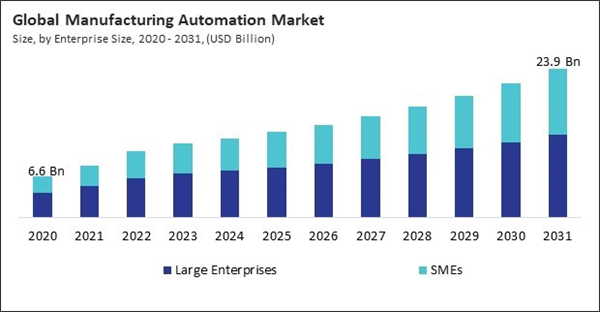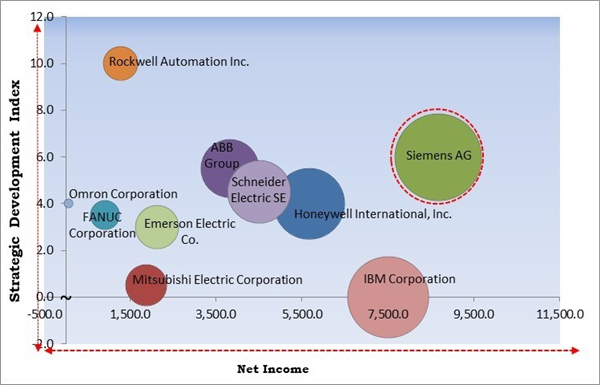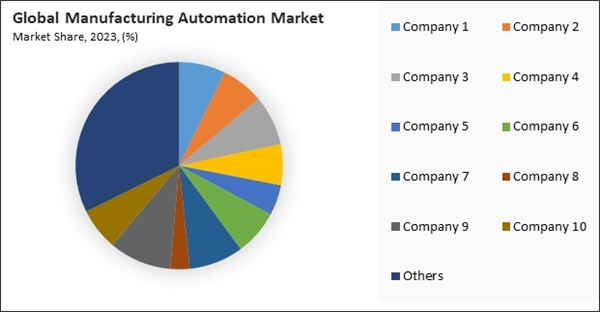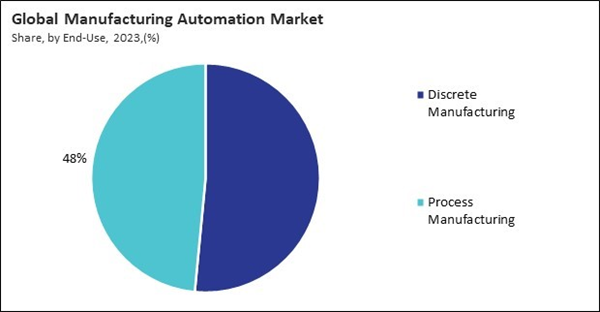Automated fabrication machines, laser cutters, and robotic welding systems have become the norm in these sectors, allowing manufacturers to enhance production throughput and adhere to rigorous quality standards. As these technologies become more accessible and advanced, their adoption continues to rise. Thus, the welding & fabrication automation segment witnessed 11% revenue share in the manufacturing automation market in 2023. These industries have adopted robotic welding systems, laser cutters, and automated fabrication machines as standard instruments, which have allowed manufacturers to enhance production throughput and adhere to rigorous quality standards.
The major strategies followed by the market participants are Partnership as the key developmental strategy to keep pace with the changing demands of end users. For instance, In September, 2024, ABB Group announced the partnership with MassRobotics, donating GoFa collaborative robots and RobotStudio simulation software to support startups in the U.S. robotics community. This aims to drive innovation by providing emerging companies access to advanced technology and fostering collaboration and breakthrough developments in the robotics industry.
Additionally, In June, 2024, Omron Corporation teamed up with Digimarc Corporation to advance industrial automation by combining Digimarc's digital watermarking with OMRON's machine vision technology. This collaboration enables innovative digital product identification, helping manufacturers and brands stay competitive, adapt to market changes, and meet sustainability and customization demands.
Cardinal Matrix - Market Competition Analysis
Based on the Analysis presented in the Cardinal matrix; Siemens AG is the forerunner in the Manufacturing Automation Market. Companies such as ABB Group, Honeywell International, Inc., and Schneider Electric SE are some of the key innovators in the Manufacturing Automation Market. In April, 2024, Siemens AG announced a partnership with Sight Machine Inc. to integrate AI into manufacturing automation networks. Sight Machine's platform analyzes manufacturing data to enhance productivity and sustainability. With Siemens' Industrial Edge, users can manage devices and applications efficiently, enabling software-defined automation and dynamic recipes for optimized production processes.Market Growth Factors
As industries face increasing pressure to deliver more output in less time, automation solutions such as robotics, AI-driven systems, and computer-controlled machinery play a pivotal role in transforming production processes. One of the primary advantages of automation technologies is their capacity to operate perpetually without interruptions, in contrast to human workers who are susceptible to fatigue, require rest, and undergo shift changes.Additionally, Process automation is also a driving force behind Industry 4.0, enabling the automation of simple and complex tasks through robotics and AI. For example, General Electric (GE) in the U.S. uses AI-powered robots in its Greenville, South Carolina plant to assemble gas turbines with high precision and efficiency. Thus, as these technologies evolve, the manufacturing automation market will continue to expand.
Market Restraining Factors
Automation systems, including robotics, AI-driven solutions, and advanced data analytics platforms, require specialized expertise to operate, maintain, and program effectively. As these technologies become more sophisticated, the demand for highly trained workers with technical knowledge and practical experience is increasing rapidly. As a result, the manufacturing automation market’s growth is hindered by the need for a more capable and tech-savvy workforce.The leading players in the market are competing with diverse innovative offerings to remain competitive in the market. The above illustration shows the percentage of revenue shared by some of the leading companies in the market. The leading players of the market are adopting various strategies in order to cater demand coming from the different industries. The key developmental strategies in the market are Partnerships & Collaborations.
Driving and Restraining Factors
Drivers
- Rising demand for productivity and efficiency
- Growing adoption of Industry 4.0 and smart manufacturing
- Increasing adoption of robotics and AI
Restraints
- Substantially high initial investment costs
- Shortage of skilled workers
Opportunities
- Growing demand for customization and shorter lead times
- Technological advancements in sensors and connectivity
Challenges
- Increased risk of cyber threats
- Legacy systems and infrastructure limitations
Component Outlook
Based on component, the market is classified into hardware, software, and services. The hardware segment garnered 50% revenue share in the market in 2023. This dominance is due to the significant demand for physical components, including industrial apparatus, sensors, controllers, and robotics, which are essential for automating manufacturing processes.Services Outlook
The services segment is further subdivided into professional services and managed services. The managed services segment recorded 58% revenue share in the market in 2023. Managed services offer manufacturers long-term support, including regular maintenance, system monitoring, and performance optimization, allowing them to focus on core operations without needing in-house technical teams.Technology Outlook
On the basis of technology, the market is bifurcated into PLC and robotics. The robotics segment garnered 45% revenue share in the market in 2023. Robotics has become essential in manufacturing environments that require high levels of precision, speed, and the ability to handle repetitive tasks.Deployment Outlook
By deployment, the market is divided into on-premises and cloud-based. The cloud-based segment acquired 36% revenue share in the market in 2023. Cloud-based automation solutions enable manufacturers to remotely monitor, manage, and control production processes, offering greater flexibility and scalability.End Use Outlook
Based on end-use, the market is segmented into discrete manufacturing and process manufacturing. The discrete manufacturing segment recorded 52% revenue share in the market in 2023. Discrete manufacturing is the process of producing unique products, including automobiles, electronics, appliances, and machinery.Industry Vertical Outlook
On the basis of industry vertical, the market is fragmented into automotive, consumer electronics, healthcare, transportation & logistics, and others. The automotive segment garnered 29% revenue share in the market in 2023. Automation technologies such as robotics, PLCs, and AI-enabled systems have become critical in automotive manufacturing for assembly, welding, painting, and quality control tasks.Application Outlook
By application, the market is divided into assembly line automation, material handling automation, welding & fabrication automation, transportation & logistics, packaging automation, and others. The assembly line automation segment acquired 28% revenue share in the market in 2023. This dominance is due to assembly lines' critical role in high-volume production environments, particularly in automotive, electronics, and consumer goods.Solution Outlook
Based on solution, the market is segmented into control systems, monitoring & diagnostics, and robotics & autonomous systems. The monitoring & diagnostics segment procured 33% revenue share in the market in 2023. Monitoring and diagnostics solutions, often integrated with industrial IoT (IIoT) sensors, allow manufacturers to track equipment performance, detect potential issues, and conduct preventive maintenance before failures occur.Enterprise Size Outlook
On the basis of enterprise size, the market is bifurcated into SMEs and large enterprises. The SMEs segment acquired 41% revenue share in the market in 2023. The rising accessibility of automation technologies to smaller manufacturers, who are seeking to improve productivity, reduce operational costs, and remain competitive in a swiftly evolving market, is the primary factor driving this growth.Regional Outlook
Region-wise, the market is analyzed across North America, Europe, Asia Pacific, and LAMEA. The Asia Pacific segment garnered 31% revenue share in the market in 2023. The region is home to some of the largest manufacturing hubs in the world, particularly in the electronics, automotive, and consumer goods sectors.Market Competition and Attributes
The market is highly competitive, driven by rapid advancements in robotics, AI, and IoT integration. Key attributes include efficiency, precision, and scalability, as well as energy efficiency and safety improvements. Automation solutions are now essential for enhancing productivity and flexibility in production lines. Market demand is fueled by sectors like automotive, electronics, and healthcare, which increasingly prioritize smart factories. Innovations in cloud computing and data analytics also play a critical role in optimizing automated processes.
Recent Strategies Deployed in the Market
- Sep-2024: ABB Group announced the partnership with MassRobotics, donating GoFa collaborative robots and RobotStudio simulation software to support startups in the U.S. robotics community. This aims to drive innovation by providing emerging companies access to advanced technology and fostering collaboration and breakthrough developments in the robotics industry.
- Aug-2024: FANUC Corporation expanded its presence in Tamil Nadu by opening a new Technology Center in Neelambur, Coimbatore. The facility will serve the region’s large industrial base, showcasing advanced factory automation technologies and reinforcing FANUC’s commitment to Indian manufacturing.
- Jun-2024: ABB Group unveiled OmniCore, an intelligent automation platform offering faster, more precise, and sustainable operations. Advanced AI, sensor integration, and edge computing enhance robot performance by 25%, reduce energy use by 20%, and enable precision tasks in industries like biotechnology and construction through its modular, future-proof architecture.
- Jun-2024: Omron Corporation teamed up with Digimarc Corporation to advance industrial automation by combining Digimarc's digital watermarking with OMRON's machine vision technology. This collaboration enables innovative digital product identification, helping manufacturers and brands stay competitive, adapt to market changes, and meet sustainability and customization demands.
- May-2024: Rockwell Automation Inc. announced the partnership with Azzurro, a subsidiary of Illukkumbura Group, to drive business growth in Sri Lanka. They will introduce smart manufacturing technologies to support the country's focus on value-added manufacturing and digital transformation, enhancing productivity, sustainability, and safety across various industries.
List of Key Companies Profiled
- ABB Group
- FANUC Corporation
- Honeywell International, Inc.
- Mitsubishi Electric Corporation
- Omron Corporation
- Rockwell Automation Inc.
- Schneider Electric SE
- IBM Corporation
- Siemens AG
- Emerson Electric Co.
Market Report Segmentation
By Enterprise Size
- Large Enterprises
- SMEs
By End-Use
- Discrete Manufacturing
- Process Manufacturing
By Component
- Hardware
- Software
- Services
- Managed Services
- Professional Services
By Technology
- PLC
- Robotics
By Solution
- Monitoring & Diagnostics
- Control Systems
- Robotics & Autonomous Systems
By Deployment
- On-premises
- Cloud-based
By Industry Vertical
- Automotive
- Consumer Electronics
- Transportation & Logistics
- Healthcare
- Other Industry Vertical
By Application
- Assembly Line Automation
- Material Handling Automation
- Transportation & Logistics
- Welding & Fabrication Automation
- Packaging Automation
- Other Application
By Geography
- North America
- US
- Canada
- Mexico
- Rest of North America
- Europe
- Germany
- UK
- France
- Russia
- Spain
- Italy
- Rest of Europe
- Asia Pacific
- China
- Japan
- India
- South Korea
- Singapore
- Malaysia
- Rest of Asia Pacific
- LAMEA
- Brazil
- Argentina
- UAE
- Saudi Arabia
- South Africa
- Nigeria
- Rest of LAMEA
Table of Contents
Companies Mentioned
- ABB Group
- FANUC Corporation
- Honeywell International, Inc.
- Mitsubishi Electric Corporation
- Omron Corporation
- Rockwell Automation Inc.
- Schneider Electric SE
- IBM Corporation
- Siemens AG
- Emerson Electric Co.
Methodology

LOADING...













